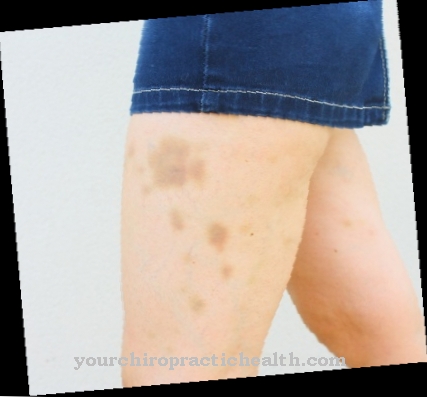Hip pain can take many different forms. An individually helpful medical treatment is based on the cause of the pain.
What is hip pain?

From an anatomical point of view, the human hip area comprises the area around the hip joint. The hip consists of the hip bone (a pair of bones in the pelvic ring) and the hip socket on both sides. If hip pain occurs, it can affect different areas of the hip.
The hip joint can also be affected by hip pain - the joint is formed from a bilateral hip socket and the respective head of the thighbones. Depending on the cause of hip pain, it can also radiate into the legs and / or feet. The pain quality of hip pain can also differ depending on the cause of the pain:
For example, the pain can only manifest itself during physical exercise or persist even when the body is at rest. Hip pain is often accompanied by feelings of stiffness or instability and restricted mobility.
causes
Possible causes of hip pain are very diverse. The most common causes include signs of wear and tear on the hip joint. Here, the joint cartilage breaks down (especially with increasing age), so that in severe cases the bones of the acetabulum and thigh collide.
This wear and tear, which can be accompanied by very severe hip pain, is also referred to in medicine as hip arthrosis (coxarthrosis). In addition to hip osteoarthritis, common causes of hip pain are, for example, associated muscles, bursae, nerves or tendons. Occasionally, hip pain can also be caused by ailments outside of the musculoskeletal system.
Bursitis, which can lead to hip pain, is caused, among other things, by physical overload or bacterial infections. Impairments to the nerves in the hip area that cause hip pain are often caused by mechanical pressure on the nerves; For example, through strong strength training, being very overweight or through seat belts and skin-tight clothing.
You can find your medication here
➔ Medicines for painDiseases with this symptom
- Hip arthrosis
- Hip dislocation
- Coxitis fugax
- Coxa saltans
- Obesity
- Femoral neck fracture
- Epiphyseal capitis femoris
- Femoral head necrosis
- Bursitis
- Meralgia paraesthetica
- Leg length difference
- Impingement syndrome
Diagnosis & course
In order to diagnose the cause of hip pain in an individual case, a detailed discussion with the patient usually takes place first. Any injuries, illnesses or operations in the past of a patient or existing congenital malformations of the bones are clarified here.
In the case of hip pain, the doctor often asks whether the pain is unilateral or bilateral and when it is particularly severe (e.g. during exercise, at night, etc.). As part of a physical examination for hip pain, for example, muscle reflexes or areas that are painful for knocking are checked. Depending on the individual case, blood tests or X-ray or ultrasound procedures can also help diagnose the cause of hip pain.
The course of hip pain depends primarily on the cause of the pain. If the hip pain is due to a cause that can be remedied or that heals on its own, this can in many cases also overcome the pain.
Complications
Whether or not there is a risk of complications with hip pain depends primarily on the underlying cause. If, for example, it is acute hip pain as a result of overloading the corresponding muscles through exercise, complications are rare. The sore muscles radiating to the hips subside after a few days so that the pain disappears.
With bursitis, on the other hand, there is a risk of more serious complications if the patient does not see a doctor. The inflammation may not heal on its own and instead spreads. This can cause long-term damage to tissue structures. In addition, hip pain is sometimes caused by serious diseases such as osteonecrosis, bone cancer or metastases.
A lack of treatment often leads to unimpeded progression of the malignant disease, which is fatal for some patients. However, the treatment of hip pain also leads to complications, which in turn depend on the underlying disease. Surgical interventions to relieve hip pain, such as the insertion of an artificial hip joint, limit mobility in some people, even with successful surgery.
In addition, as a result of the therapy, patients sometimes suffer from walking difficulties and persistent pain. Treatment of osteoporosis slows down the progressive breakdown of bone substance, but does not stop the disease. This means that the patient is at risk of both bone fractures and restricted mobility.
When should you go to the doctor?
Hip pain as a result of short-term overload can recede even without medical treatment through rest and exercise therapy. If these measures do not relieve the symptoms, the pain should be clarified by a doctor.
A doctor should also always be consulted if the hip pain worsens even when you take care of it, persists for more than two weeks, radiates into the foot and severely restricts movement. Early treatment prevents pathological changes in ligaments, tendons, muscles and joints. If additional symptoms such as swelling and / or tenderness occur, a doctor should always be consulted.
People with a recent accident trauma, hip arthrosis or suspected other previous illnesses should also have the pain clarified by a doctor. Hip pain that occurs in children as part of a flu-like infection, tonsillitis or otitis media (so-called hip rhinitis) is usually harmless and regresses within two weeks with care.
If the child repeatedly complains of pain in the hip joint or cannot walk properly ("it limps"), a pediatrician should be consulted. The same applies to persistent (persistent) fever after the infection has subsided and swellings appear.
Doctors & therapists in your area
Treatment & Therapy
The medical treatment of hip pain is primarily aimed at the causes of the pain. An important component of therapy for the treatment of hip pain is often the use of pain reliever or anti-inflammatory drugs.
For example, if a patient has acute hip pain that is caused by inflammatory processes in the hip area, cold packs and physical protection of the hip can also have a positive effect on the symptoms in the first few days. In the presence of chronic hip pain (according to the medical definition, this is the case if the pain has been evident for more than 3 months) that are not caused by inflammation, physiotherapy (physiotherapy) and heat packs can bring about relief in parallel to any drug therapy.
Alternative medical approaches offer a number of other therapy methods. If hip pain is caused by degenerative processes such as hip arthrosis, there is the possibility of surgical measures depending on the individual case: One possibility is the insertion of an artificial hip joint. In this way, both hip pain and restricted mobility can usually be combated.
Outlook & forecast
There are many different treatments that can be used to control and manage hip pain. Treatment with painkillers can be short-term, but should not be designed for the long term, as these drugs also put a strain on the body.
The symptoms can worsen if the patient continues to be exposed to vigorous physical exertion or engages in strenuous sports. Often surgical interventions are also necessary in which an artificial hip joint is used to reduce hip pain and allow the patient freedom of movement. The hip pain severely restricts the person's movement and mobility.
In the case of inflammations or infections, cold treatment is carried out, which can relieve the symptoms. Physiotherapy is also helpful in most cases and can restore the patient's movement. If hip pain persists, many self-help remedies can be used to combat it. These include, for example, quark wraps or stretching exercises.
You can find your medication here
➔ Medicines for painprevention
Hip pain, which is caused by factors such as injuries or acute inflammatory processes, can only be prevented to a limited extent. If, on the other hand, hip pain is caused by long-term processes such as hip wear, a worsening of symptoms can be counteracted by an early visit to the doctor; With the help of appropriate measures, the progression of causal processes and associated hip pain can often be reduced.
You can do that yourself
If a bursitis is the cause of the hip pain, a lot of rest usually helps. Envelopes or quark wraps can also help. If acute injuries or swelling are the cause of hip pain, the use of ice packs is recommended. They should be used within 48 hours of the injury to relieve swelling and reduce pain. Ice packs can also help with chronic hip pain.
Warmth is good for many patients with hip pain. Infrared, red light or a lava pillow are useful sources of heat. Essential oils can also help relieve hip pain. The diseased hip joint can be rubbed with chamomile oil or tea tree oil. In addition, arnica flowers, devil's claw or hay flower baths can relieve pain in the hip. Joint wraps made from healing clay are also useful. The healing clay paste is applied as thick as a finger to the painful areas of the body and covered with a damp cloth. Then let the healing clay dry and remove it after about two hours.
A lot of movement and training of the joints helps with hip pain. However, during all exercises and movements, it is important to ensure that the hip joint does not hurt. Joint-friendly sports such as swimming or cycling are recommended. Stretching and stretching exercises are also useful. Obese patients with hip pain should reduce their weight. With lower body weight, the hip joint is less worn and mobility is improved. Fitness activities are also made easier.













.jpg)

.jpg)
.jpg)











.jpg)